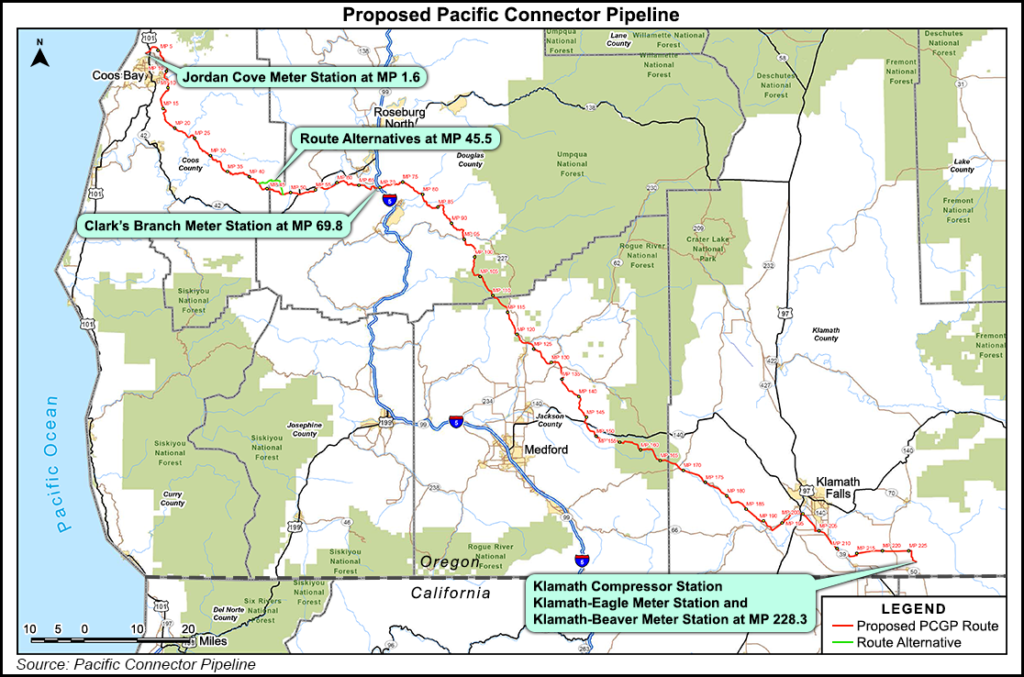E&P | LNG | NGI All News Access
Western Colorado Producers Eye Jordan Cove LNG Project as Market Outlet
Government, economic development and gas industry officials in Western Colorado are continuing to ride the bandwagon of Veresen Inc.’s $7 billion Jordan Cove liquefied natural gas (LNG) export project as a conduit for Piceance Basin gas to reach international markets.

Earlier this year, elected officials in natural gas-rich Garfield County in the Piceance wrote FERC urging expedited approval of the proposed Jordan Cove LNG export project along the south-central Oregon coast at Coos Bay (see Daily GPI, Feb. 24).
Following the recent final Federal Energy Regulatory Commission staff environmental impact statement (EIS) for the project (see Daily GPI, Sept. 30), Western Slope supporters in Colorado are working on the next steps toward construction of the first U.S. West Coast LNG export terminal. FERC is expected to make a final determination on the project in December, offering Piceance Basin gas producers an outlet to reach Pacific Rim customers.
The Association of Governments of Northwest Colorado and the West Slope chapter of the Colorado Oil and Gas Association (COGA) have been leading efforts in support of the terminal, which would process up to 1 Bcf of gas for export in what would essentially be a tolling facility. From the perspective of Colorado West Slope producers, this is a perfect time to be sizing up interest in Pacific Rim markets, said David Ludlam, executive director of the West Slope COGA.
Ludlam said that Colorado Gov. John Hickenlooper this summer endorsed the Jordan Cove project, and he is in the midst of a multi-nation trade mission trip to the Far East. The trip is scheduled to include a stop in Tokyo, where Hickenlooper is set to promote his state’s oil/gas resources, among other products.
“We have 30 years of production data to show that we have very low declines in very valuable assets with probably more than 20,000 future drilling locations in the Mesa Verde,” Ludlam said. “And with all of the infrastructure in place, we have the Niobrara that hasn’t been touched yet.”
In addition, Ludlam and the pro-Jordan Cove effort are touting “no restrictions” in pipeline takeaway capacity from the region. “We think now is the perfect time for our producers to be having conversations [with regulators, Veresen and potential Asian buyers],” Ludlam said.
Ludlam confirmed that some agreements should be completed in the time between FERC making a final determination and Veresen finalizing financing for the project, which includes the 232-mile Pacific Connector transmission pipeline link to Malin where the Ruby pipeline interconnects with existing interstate pipelines out of western Canada.
“If we have this facility, it cuts nine days off the shipping time to Asian markets [compared to shipment from the Gulf of Mexico],” Bonnie Petersen, executive director of the Associated Governments of Northwest Colorado, told local news media following FERC’s final EIS last Wednesday.
Supporters have been emphasizing that the Oregon pipeline and export terminal can meet any mitigation requirements in the final EIS, and a coalition of groups from the governor on down have taken a number of steps since a white paper on the Pacific Rim market’s attractiveness was submitted last December to the Western Slope local government.
Ludlam said the export project would have “a multitude of benefits for our area and for our economy.” The Grand Junction Economic Partnership and other organizations are working with Ludlam to coordinate support for the export terminal.
Assuming approval by FERC in December, the earliest natural gas would be shipped west from the terminal would be in 2020.
Conservation groups and private landowners have challenged the pipeline, vowing to take legal action to halt the project.
© 2024 Natural Gas Intelligence. All rights reserved.
ISSN © 1532-1231 | ISSN © 2577-9877 |
